 Transportation of the patient to the department
Transportation of the patient to the department
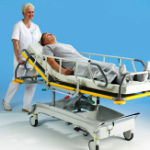
In nursing, one of the important skills is the safe transportation of the patient to the department upon admission to the hospital, as well as to auxiliary rooms as prescribed by the doctor. The purpose of this manipulation is to create maximum rest for the patient when moving.
Depending on the severity of the patient's condition, the doctor determines the type of transportation:
- on foot;
- in a wheelchair
- on a wheelchair;
- on a stretcher;
- on hands.
If the patient can walk, he is transported to the department on foot , but accompanied by a medical worker.
Children and patients with low body weight are transported on their hands for short distances, as well as adult patients, if it is not possible to use a stretcher.
Transporting a patient in a wheelchair
Carried out by a single healthcare professional. Sequencing:
- Check the serviceability of the wheelchair, prepare it for work.
- Tilt the wheelchair forward by stepping on the footrest.
- Ask the patient to stand on this stand and seat him in a chair, supporting him under his back.
- Bring the wheelchair to its original position.
- Give the patient the required position (sitting or reclining) using the frame located behind the back of the chair.
- Cover the patient with a blanket or sheet.
- Control the position of the patient's arms so that they do not go beyond the armrests during transportation.
- Upon arrival at the destination, help the patient to transfer to the bed in the ward.
Transporting a patient on a stretcher
Carried out by two healthcare professionals. Sequence of actions and safety rules:
- Inform the patient about the progress of his upcoming transportation.
- Place the patient on the stretcher with their head in the direction of travel.
- Two paramedics should raise and lower the stretcher simultaneously, leaving the stretcher in a horizontal position, at the same height of the head and foot ends.
- The patient should be carried head first, carefully, without shaking, without swinging the stretcher, taking short steps out of step.
- A medical worker walking behind should observe the patient's condition, inquire about his well-being.
- When climbing stairs, the stretcher should be carried with the head end forward, lifting the foot end and leaving the stretcher in a horizontal position.
- When descending the stairs, carry the stretcher with the foot end forward, also lifting the foot end of the stretcher.
- If any of the staff is tired, this should immediately be reported to the rest of the participants in the transportation, then stop and lower the stretcher. Apart from fatigue, the healthcare worker's fingers can relax and release the handles of the stretcher, resulting in the patient falling along with the stretcher.
Transporting a patient on a wheelchair
Conducted by three medical professionals. Sequence of actions and safety:
- Check for serviceability and prepare the wheelchair for transportation.
- Lay a blanket on the stretcher so that half of it (vertically) remains free. Cover the blanket with a sheet, put a pillow.
- Place the wheelchair at right angles to the head of the bed or couch.
- Raise the patient - one health worker brings his hands under the neck and upper body, the other - under the lower back, the third - under the hips and shins.
- Lift the patient, turn with him 90 degrees and put him on a stretcher.
- Cover the patient with the free end (half) of the blanket and sheet.
- One medical worker stands in front of the gurney, the other behind, facing the patient.
- Transportation of the patient on a stretcher is carried out with the head end forward.
Wheelchairs and stretchers, on which the patient is transported to the department and for examination and treatment, should be equipped with mattresses lined with oilcloth and covered with sheets. A pillow in an oilcloth pillowcase is placed under the head, on which a cloth pillowcase is put on.
The patient is covered depending on the time of year and the air temperature in the premises of the medical institution (if it is cool or cold - with a blanket, warm - with a sheet).
Each patient should be provided with clean linen, which should be thrown into a dirty linen bag after transport.
The mattress, pillow, surface of the wheelchair must be rubbed twice with a rag soaked in a disinfectant solution.
Features of transportation of patients depending on the disease
Patients with acute disorders of cerebral circulation and hemorrhages in the brain are transported in the supine position.
When the patient is unconscious, the patient's head should be turned to the side to prevent vomit from entering the respiratory tract.
With cardiovascular insufficiency, patients are given a semi-sitting position, because. due to severe shortness of breath, possible pulmonary edema, they cannot lie down. Such patients are especially sensitive to cold, so they need to be covered, applied to the legs and arms of a heating pad.
Patients with acute vascular insufficiency should be placed so that the head end is lower than the foot end.
Seriously ill patients require very careful transport, as well as careful transfer from a gurney to a bed. Consideration should be given in advance to how to place the gurney relative to the bed when transferring the patient to avoid unnecessary and unnecessary movements.
The stretcher should be placed parallel to the bed so that its head end is located towards the foot end of the bed. The medical staff stands between the gurney (stretcher) and the bed facing the patient, two or three of them lift the patient, and, turning 180 degrees, lay him on the bed.
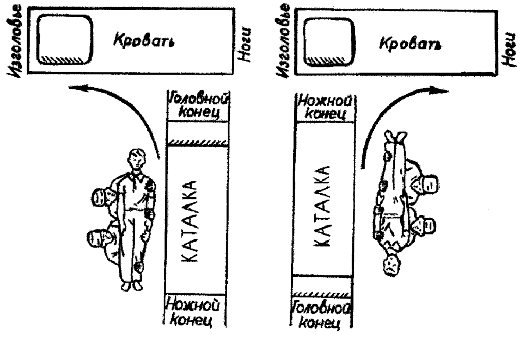
For the convenience of carrying the patient, the wheelchair can be placed in relation to the bed at a right angle, sequentially (head end to foot end) and close (head end to head end).

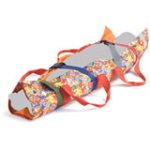
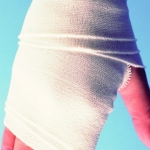
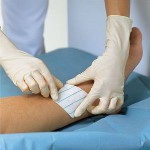
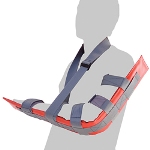

Judging by the pictures in the text, its authors did not study well at school, because. confuse the concepts of "parallel" and "perpendicular"!